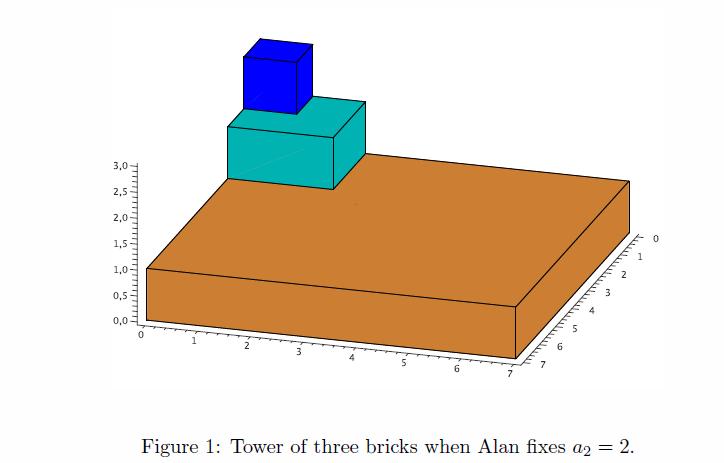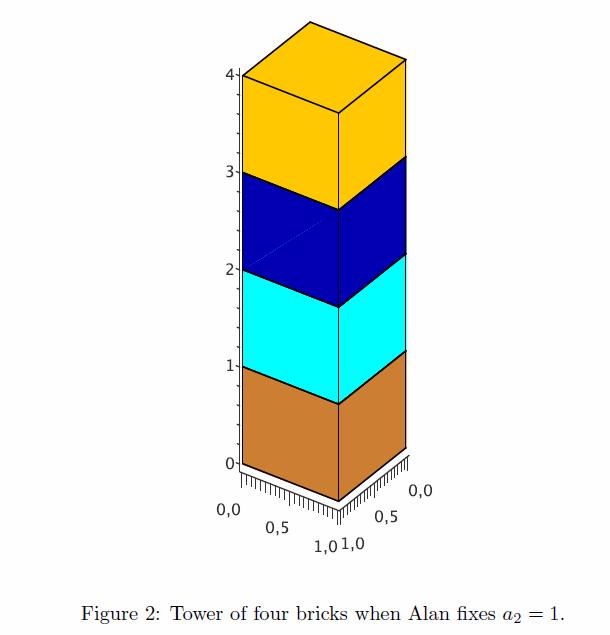当前你的浏览器版本过低,网站已在兼容模式下运行,兼容模式仅提供最小功能支持,网站样式可能显示不正常。
请尽快升级浏览器以体验网站在线编辑、在线运行等功能。
2971:Tower
题目描述
Alan loves to construct the towers of building bricks. His towers consist of many cuboids with square base. All cuboids have the same height h = 1. Alan puts the consecutive cuboids one over another:

Recently in math class, the concept of volume was introduced to Alan. Consequently, he wants to compute the volume of his tower now. The lengths of cuboids bases (from top to bottom) are constructed by Alan in the following way:
1. Length a1 of the first square is one.
2. Next, Alan fixes the length a2 of the second square.
3. Next, Alan calculates the length an (n > 2) by 2*a2*(an-1)-(an-2). Do not ask why he chose such
a formula; let us just say that he is a really peculiar young fellow. For example, if Alan fixes a2 = 2, then a3 = 8 -a1 = 7; see Figure 1. If Alan fixes a2 = 1, then an = 1 holds for all n belong to N; see Figure 2.
Now Alan wonders if he can calculate the volume of tower of N consecutive building bricks. Help Alan and write the program that computes this volume. Since it can be quite large, it is enough to compute the answer modulo given natural number m.

Recently in math class, the concept of volume was introduced to Alan. Consequently, he wants to compute the volume of his tower now. The lengths of cuboids bases (from top to bottom) are constructed by Alan in the following way:
1. Length a1 of the first square is one.
2. Next, Alan fixes the length a2 of the second square.
3. Next, Alan calculates the length an (n > 2) by 2*a2*(an-1)-(an-2). Do not ask why he chose such
a formula; let us just say that he is a really peculiar young fellow. For example, if Alan fixes a2 = 2, then a3 = 8 -a1 = 7; see Figure 1. If Alan fixes a2 = 1, then an = 1 holds for all n belong to N; see Figure 2.
Now Alan wonders if he can calculate the volume of tower of N consecutive building bricks. Help Alan and write the program that computes this volume. Since it can be quite large, it is enough to compute the answer modulo given natural number m.
输入解释
The input contains several test cases. The first line contains the number t (t <= 10^5) denoting the number of test cases. Then t test cases follow. Each of them is given in a separate line containing three integers a2,N,m (1 <= a2,m <= 10^9, 2 <= N <= 10^9) separated by a single space, where a2 denotes the fixed length of second square in step 2, while N denotes the number of bricks constructed by Alan.
输出解释
For each test case (a2,N,m) compute the volume of tower of N consecutive bricks constructed by Alan according to steps (1-3) and output its remainder modulo m.
输入样例
3 2 3 100 1 4 1000 3 3 1000000000
输出样例
54 4 299
提示
来自杭电HDUOJ的附加信息
| Recommend | lcy |
最后修改于 2020-10-25T22:58:46+00:00 由爬虫自动更新
共提交 0 次
通过率 --%
| 时间上限 | 内存上限 |
| 10000/5000MS(Java/Others) | 32768/32768K(Java/Others) |
登陆或注册以提交代码
